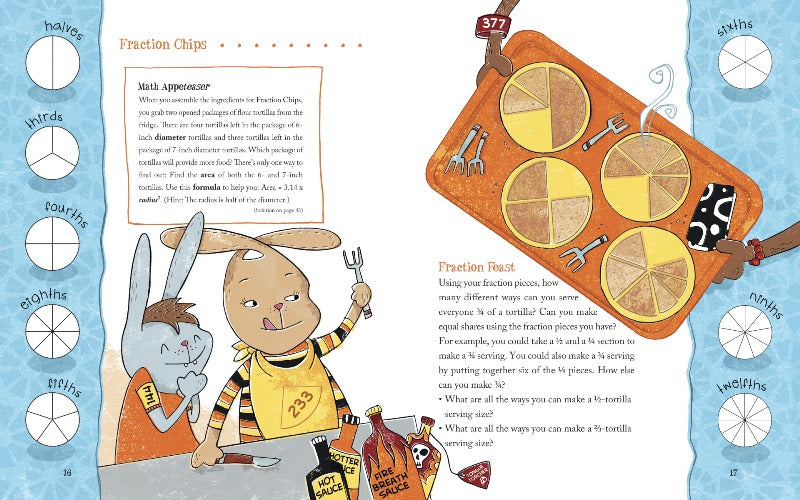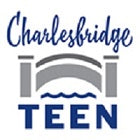Eat Your Math Homework

Ann McCallum, author
Ann McCallum is the author of several books, including Eat Your Math Homework; Eat Your Science Homework; Rabbits, Rabbits Everywhere; and Beanstalk: The Measure of a Giant. She is currently a high school teacher in Maryland, though she started her teaching career in a one-room schoolhouse in northern Canada. She also taught English composition in the United Arab Emirates for five years. Ann enjoys reading, traveling, and walking through leaves, and hopes, one day, to climb a beanstalk.
Read more about Ann.
Leeza Hernandez, illustrator
Leeza Hernandez is an illustrator and graphic designer whose art has been featured in magazines, newspapers, and books, including Eat Your Math Homework; Eat Your Science Homework; and Never Play Music Right Next to the Zoo (Simon & Schuster). She's also written and illustrated books, including Catnapped (G.P. Putnam's Sons). She is the recipient of the Tomie dePaola Portfolio award from the Society of Children's Books Writers and Illustrators. She lives in Upper Montclair, New Jersey.
Read more about Leeza.
- Book Links Lasting Connections
- Bank Street College of Education's Best Children's Books of the Year
Kirkus Reviews
Math and cooking have always gone hand-in-hand, but McCallum takes it to a whole new level that allows young number lovers to explore (and eat!) a wide range of mathematical topics.
While the supply list and preparation time may preclude these from actually being assigned as homework, kids who are mathematically minded will enjoy snacking and learning their way through the recipes. Well-written and easily followed, the recipes include Fibonacci snack sticks based on the famous sequence of numbers, fraction chips made from cut-up tortillas, tessellating two-color brownies, milk and tangram cookies, variable pizza pi and probability trail mix. McCallum does not shy away from using appropriate vocabulary, defining it both in context and in the glossary at the back. She also includes fascinating historical tidbits that allow readers to see the precursors of today’s math and the mathematicians that first explored them. Hernandez cleverly folds math into her illustrations, too—observant readers will notice the numbers emblazoned somewhere on each character, but only the mathematically informed will figure out their pattern. Her high-energy mixed-media artwork is filled with humorous details, while her cartoon rabbits are likely to remind kids of the Arthur cartoons. Excellent backmatter helps review concepts.
A yummy way to get parents and kids to more deeply understand math…and spend some time together in the kitchen.ChopChop Magazine
Something as simple as making a kabob can be an opportunity for a math lesson. There is no question that cooking involves math skills, from simple addition to the more complicated concepts like infinity and tessellation, that McCallum whimsically explains in her book. With lessons/recipes for Fibonacci Snack Sticks and Probability Trail Mix, you’ll eat well and learn something in the process. I know I did.
Publishers Weekly
Mischievous, gap-toothed bunnies rendered in mixed-media collage explore math in the kitchen in this clever activity book. Each of the six simple recipes introduces a math concept (for a lesson on fractions, pie-charts demonstrate what it means to cut something in halves, fourths, eighths, etc.), followed by a recipe that challenges readers to apply that concept (such as "Fraction Chips" made from tortillas, or "Milk and Tangram Cookies"). Another recipe instructs readers on how to build snack kebabs by following the Fibonacci sequence, and homemade trail mix provides a hands-on way to experiment with probability. Adult supervision doesn't just apply to the recipes - it'll come in handy for working through the mathematical concepts, too.
BayViews
If you imagine math homework might taste like paper, then the appearance of this book’s cover won’t surprise you. However, the recipes inside are appealing. They include fruit kabobs to show Fibonacci numbers, fresh tortilla chips to work with fractions, brownies to play with tessellated polygons, ginger cookies to make tangrams, pizza to measure pi, and trail mix to demonstrate probability. Despite the cooking call number, the content is actually mathematical experiments, and although teachers would be the best audience, a young person could find her way through the material. Each section includes some math background information, one recipe, an experiment or process to apply the math concept to the food, and an “Appeteaser”— an inset question that uses the food to illustrate a related mathematical concept. Some of the specific details of the processes are not well thought through. For example, McCallum suggests people first fry the tortillas and then cut them, but they will crack and break after frying, whereas beforehand, they can easily be cut with scissors or a knife. Similarly, to make half the brownies white, readers are told to use powdered sugar, applied before slicing, which is not the best order to proceed. Hernandez’s cartoon illustrations may appeal to the target readers in third through sixth grades and may also help clarify the instructions.
School Library Journal
These edible math projects highlight six significant concepts. Each entry includes a brief narrative explanation, followed by cooking instructions that demonstrate teh concept in a practical and hands-on way. From "Fibonacci Snack Sticks" (a simple, no-cook kabob recipe) to the more complicated "Tessellating Two-Color Brownies" and "Variable Pizza Pi," the recipes will appeal to most youthful palates. The book is heavily illustrated with digitally enhanced cartoon-style pictures of anthropomorphic animals that, unfortunately, lend the presentation of a younger tone than the content demands. Overall, though, larger collections may want to consider this worthwhile attempt to bring math learning into the classroom or family kitchen in a lively way.
Chicago Tribune
An easy way to help children learn math? Get them in the kitchen mixing up variable pizza pi, says Ann McCallum, a Maryland mom, math teacher and author of "Eat Your Math Homework: Recipes for Hungry Minds".
Whimsical illustrations fill the slim volume that features six recipes keyed to, among other concepts, fractions, triangles (remember isosceles?) and probability.
Steer clear of making the recipes into lessons, she cautions: "That takes all the spontaneity and fun out of it. You're just trying to build a love of math and kind of an inquisitiveness so kids will not be so intimidated."
If you've used Cheerios to teach addition or a stick of butter to teach fractions, McCallum takes it to the next step, mixing math words with stories about famous figures like Italian math guy Fibonacci, who came up with a sequence that adds the first two numbers to get the next one (i.e., 112358 …).
McCallum uses kebab sticks and fruit pieces for Fibonacci snack sticks: "Put one strawberry and one slice of banana. Then two grapes. Then three pieces of kiwi … and you've modeled the Fibonacci sequence. It's a stepping off point for getting into patterning and sequencing."
McCallum's efforts to make math fun extend to her blog (annmccallumbooks.com/blog/), where meatballs take the drudgery out of learning multiplication by arranging a dozen meatballs on a plate (3 by 4, or 2 by 6). "It's much better if you can have something tangible, something visual … something edible."
Booklist
McCallum combines math with cooking in this attractive book. After a brief introduction and a few basic cooking tips, she explains the Fibonacci sequence and shows how to demonstrate it using chunks of fruit on skewers. Fractions are expressed through fried flour tortillas cut into fractional portions; tessellations with two-tone brownies; tangrams with flat cookies; variables and pi with pizza; and probability with trail mix. In six-page chapters, the recipie sounds good, the math is clearly explained, and there's a playfulness of presentation that makes each activity look inviting. The mixed-media illustrations feature dressed rabbits, whose zany attitudes broaden their appeal. A math-review section and a glossary are appended. Although the activities will make lively additions to classroom units, they are also well suited to home use. Witty and smart, this unusually upbeat math book offers edible rewards for learning.
Washington Parent
Turn math lessons into tasty treats with “recipes for hungry minds” created by local author Ann McCallum. Two funny bunnies whip up snacks, such as “Variable Pizza Pi,” “Fraction Chips,” “Probability Trail Mix” and “Tesselating Two-Color Brownies.” McCallum serves up a mix of kitchen tips and recipes, math history, problems and a glossary. Leeza Hernandez sprinkles the whole with lively mixed-media illustrations. Look for the wordless subtext involving a persnickety pup and the homework in his dog dish. This book offers much food for thought—and tummies. Budding chefs may even wish to contribute some “Fibonacci Snack Sticks” to the family's Thanksgiving feast.
Picture Book Reviews
Fun recipes put emphasis on key math concepts to transform math into fun edible projects. What better way to spice up math than to pair it with kids friendly foods? Choose your level of difficulty from easy to somewhat challenging. Combining cooking and math under one cover is brilliant and is sure to ignite an interest in both subject areas. Cartoon illustrations add to the fun. Learn Fibonacci’s sequence with skewered snacks and so on. Don’t be deceived by the playful cartoon artwork; the concepts within are more advanced than would be expected by appearance. Complete with glossary and historical math facts.
Paperback
ISBN: 978-1-57091-780-6
E-book PDF
ISBN: 978-1-60734-302-8
Ages: 7-10
Page count: 48
8 x 10





